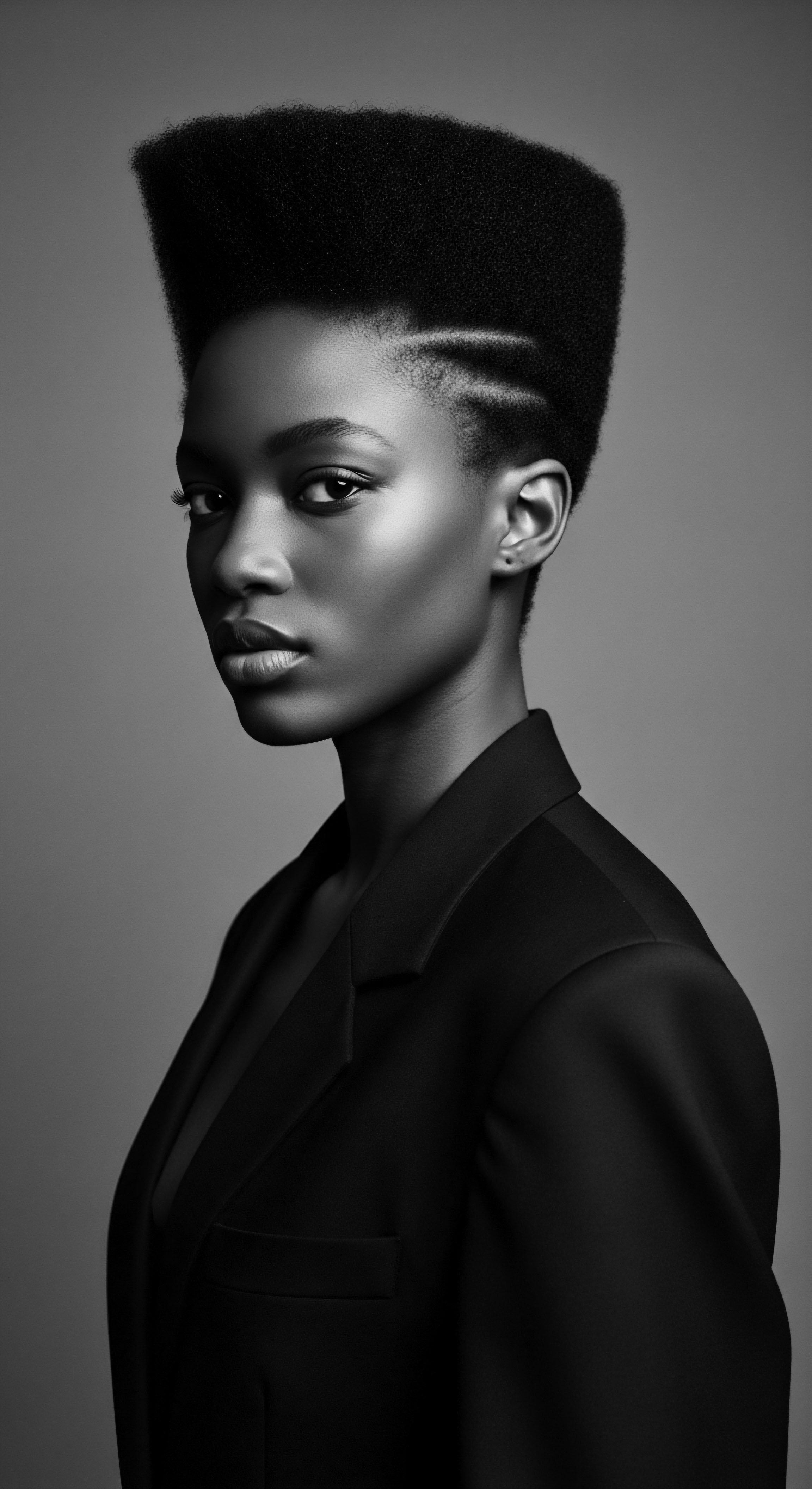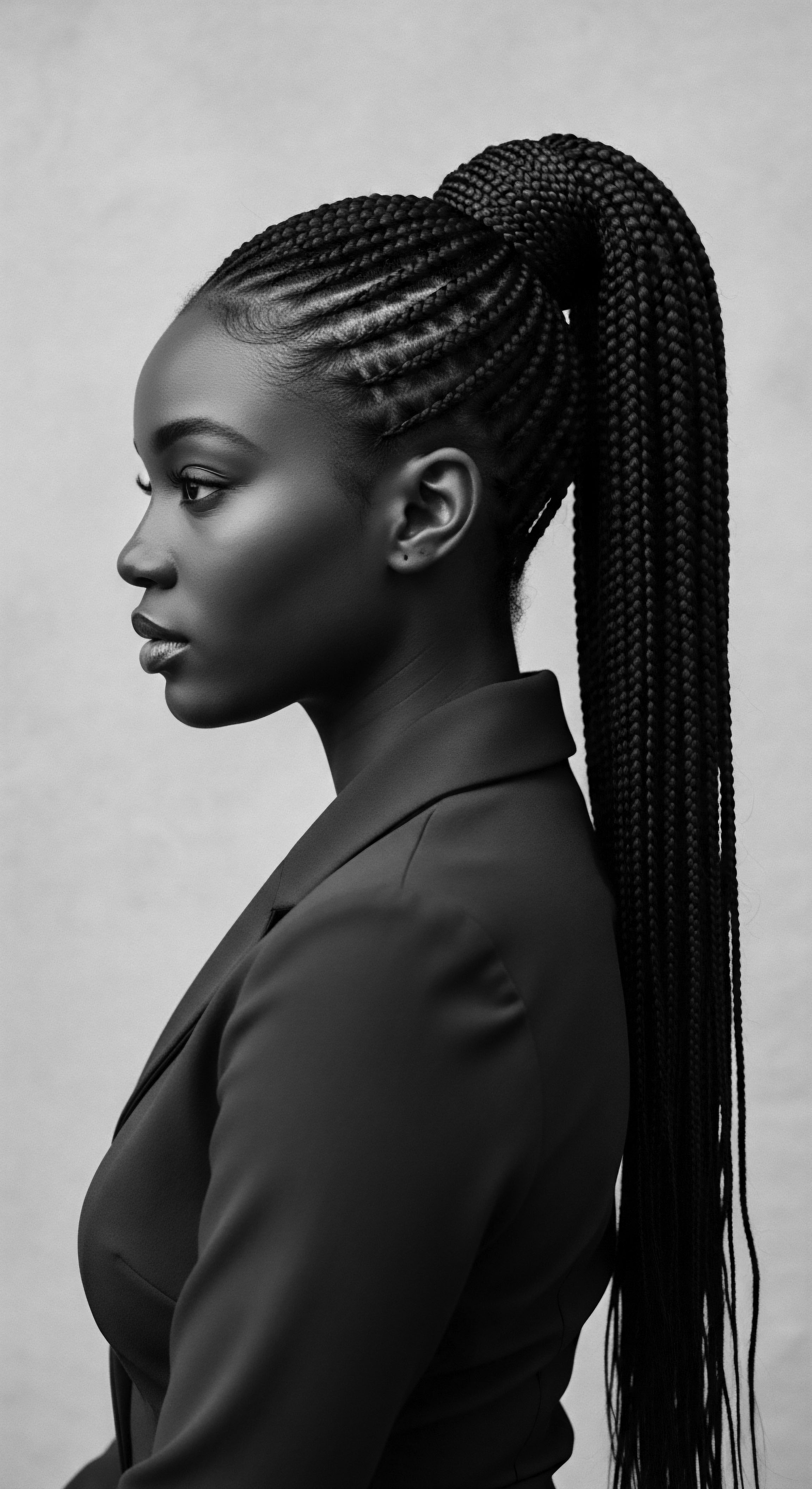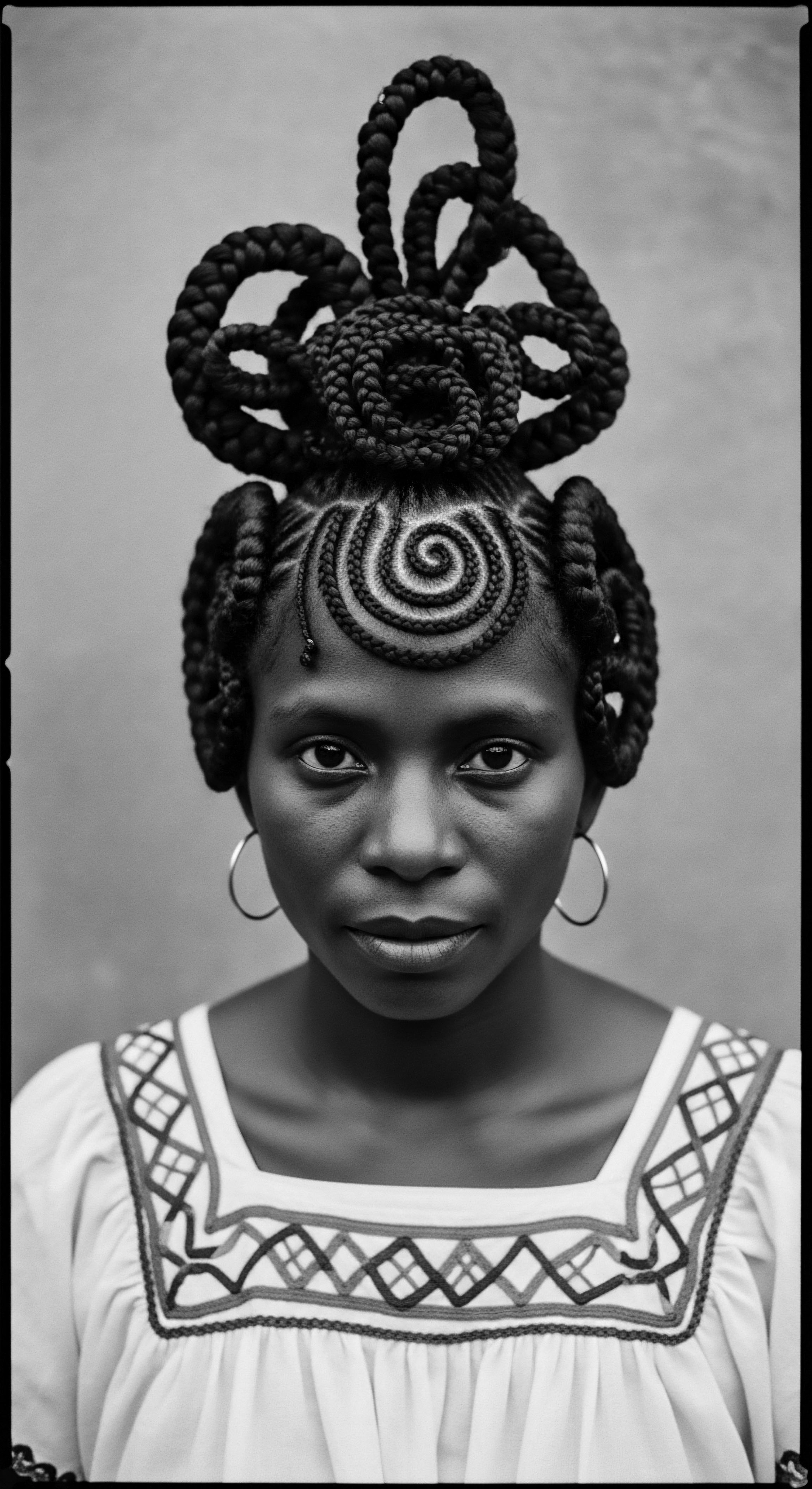
Roots
The story of textured hair, for Black communities across continents and through time, is a vibrant chronicle of resilience, ingenuity, and a profound connection to the earth. It is a narrative held not just in oral traditions or faded photographs, but in the very botanical allies that have nurtured generations of coils, kinks, and waves. These are not merely ingredients; they represent an unbroken lineage, a whispered dialogue between ancestral hands and the potent gifts of the land. Each leaf, each seed, each bark carries a silent testimony to the wisdom that sustained hair health and beauty through trials and triumphs, shaping identities long before modern science began to unravel their compounds.

The Botanical Ancestry of Textured Strands
The inherent structure of textured hair – its unique curl patterns, varying porosity, and distinct susceptibility to environmental factors – necessitated a specialized approach to care. This wasn’t a choice born of trends, but a deep, responsive understanding of biology informed by centuries of observation. The plants that became staples were chosen for specific properties ❉ their ability to retain moisture in arid climates, to provide slip for detangling delicate strands, to offer anti-inflammatory comfort to the scalp, or to impart strength against breakage. This ancestral knowledge, passed down through families and communities, represents the earliest form of phytochemistry applied to hair, long before laboratories existed.
Consider the Shea Tree (Vitellaria paradoxa), a towering emblem across West Africa. Its nuts yield a butter, known as Karite, which has been a cornerstone of skincare and hair care for millennia. Its rich emollient properties provided a shield against the harsh sun and winds, sealing moisture into hair that naturally struggles with hydration due to its helical structure.
The process of extracting shea butter, often a communal effort, transformed a botanical resource into a powerful symbol of collective care and shared heritage. The very act of gathering and preparing the nuts became a ritual, binding women across generations, the rhythmic pounding echoing the deep roots of their practices.

How Do Hair Care Plants Reflect Black Hair Biology?
The intrinsic characteristics of textured hair – its elliptical follicle shape, uneven distribution of keratin, and fewer cuticle layers that lay flat compared to straight hair – make it inherently prone to dryness and breakage. Ancestral communities intuitively understood these vulnerabilities, even without microscopic lenses. They sought out plants whose properties addressed these exact needs.
The mucilaginous quality of plants like Aloe Vera, for example, offered both hydration and detangling slip, crucial for managing tightly coiled strands. The saponins in certain barks and leaves provided gentle cleansing without stripping natural oils, a thoughtful approach to a hair type that thrives on moisture retention.
Ancestral botanical knowledge offered solutions tailored to the unique physiological needs of textured hair, demonstrating an intuitive understanding of its inherent structure.
This deep biological understanding, interwoven with cultural practice, distinguishes the heritage of Black hair care plants. It wasn’t just about making hair look good; it was about protecting its integrity, promoting its health, and honoring its very nature. The plants became extensions of human wisdom, bridging the gap between elemental biology and sophisticated care regimens. They highlight how environmental observations led to precise botanical applications, forming a foundational lexicon for hair wellness that has endured.
| Plant or Derivative Shea Butter (Karite) |
| Traditional Application (Heritage) Moisturizer, protective balm against elements, hair softener. |
| Relevance to Textured Hair Biology Rich in fatty acids and vitamins A and E; forms a protective barrier to seal moisture in porous, breakage-prone textured hair. |
| Plant or Derivative Aloe Vera |
| Traditional Application (Heritage) Soothing scalp treatment, detangler, hydrating gel. |
| Relevance to Textured Hair Biology Contains enzymes that promote healthy cell growth, provides slip for gentle detangling, and its humectant properties draw moisture to strands. |
| Plant or Derivative Chebe Powder |
| Traditional Application (Heritage) Hair strengthening mask, length retention aid. |
| Relevance to Textured Hair Biology Alkaloids in the powder coat the hair shaft, reducing breakage and enabling greater length retention, especially for fine, delicate coils. |
| Plant or Derivative These plant-based remedies reveal an enduring lineage of care, where natural resources provided targeted solutions for the unique requirements of textured hair. |

Ritual
The preparation and application of hair care plants within Black communities transcend mere cosmetic routines; they embody deeply ingrained rituals, acts of familial love, and expressions of collective identity. These practices, rooted in the rhythms of daily life and special occasions, transformed humble botanicals into conduits of heritage. The textures, scents, and sensations associated with these plant-based elixirs became sensory markers of belonging, passed from elder to youth, echoing the sacred bond between people, their hair, and the earth.

How Did Ancestral Hands Prepare These Remedies?
The methods of preparing these plant-derived remedies were as significant as the plants themselves. Consider the meticulous process of transforming the raw nuts of the Shea Tree into its creamy butter. This often involved arduous steps ❉ gathering, cracking, roasting, grinding, and kneading, sometimes over days. Each stage was performed with intention, often accompanied by storytelling, songs, or shared silence, turning the labor into a communal ceremony.
Similarly, the preparation of infusions from herbs like Fenugreek or decoctions from barks involved specific steeping times, temperature controls, and sometimes combinations with other elements, all refined through generations of trial and observation. These weren’t arbitrary steps; they were codified practices, ensuring the potency and efficacy of the botanical preparations.
In Chad, the Basara Arab women’s practice with Chebe Powder illustrates this perfectly. This blend of ingredients—including shébé seeds, mahlab, misic, clous de girofle (cloves), and samour (perfume resin)—is painstakingly prepared. The raw ingredients are roasted, ground, and then mixed into a fine powder. This powder is then incorporated into a hair oil or cream, which is applied to the hair, usually braided, not rinsed out, and reapplied regularly.
This method, passed down through generations, has been documented to contribute to extraordinary hair length retention among these women, often reaching hip or even floor length (Adongo, 2017). This traditional formulation and continuous application ritual speak volumes about the deep understanding of hair needs and the dedication to specific, inherited practices.

Traditional Styling and Plant Allies
Many traditional African hair styling techniques relied heavily on plant-based emollients and treatments to prepare the hair, protect it, and maintain its health during styling. For instance, before intricate braiding or cornrowing, hair might be softened and conditioned with specific oils or butters derived from plants. This facilitated the styling process, reducing breakage and discomfort. The application of these plant-based preparations was often the first step in a styling session, a tactile invitation into a moment of communal care.
- Palm Oil ❉ In some West African cultures, deeply pigmented red palm oil was used not only for its conditioning properties but also to add a distinctive reddish hue to the hair, particularly in styles for ceremonial occasions.
- Black Castor Oil ❉ The distinctive, thick Jamaican Black Castor Oil, derived from roasted castor beans, gained prominence for its purported ability to thicken hair and promote growth, especially after periods of intense styling or manipulation. Its heavy consistency provided significant lubrication and protection for delicate strands.
- Ayurvedic Herbs ❉ While originating in South Asia, herbs like Bhringraj (False Daisy) and Brahmi (Bacopa monnieri) found their way into diasporic Black hair care practices, particularly among those seeking holistic, natural solutions, adapting ancestral wisdom from various global traditions.
The tools used in these styling practices were often fashioned from natural materials, creating a harmonious extension of the plant-based remedies. Combs carved from wood, gourds used for mixing, and natural fibers for wrapping hair further solidified the holistic connection to the environment. These tools and techniques, augmented by the specific properties of hair care plants, transformed the hair into a canvas for communal artistry and personal expression.
The communal aspect of preparing and applying plant-based hair remedies solidified bonds, transforming routine care into shared acts of heritage and affection.

Relay
The legacy of hair care plants in Black communities extends beyond individual application; it represents a living relay of knowledge, a continuous conversation between past generations and future aspirations. This exchange safeguards ancestral wisdom, reinterprets it for contemporary realities, and positions textured hair not as a challenge, but as a rich inheritance demanding respectful and informed care. The plants themselves become symbols of endurance, their continued relevance a testament to the power of tradition in shaping identity and fostering wellness across the diaspora.

How Do Modern Practices Connect to Ancient Plant Wisdom?
In the modern landscape of hair care, there is a discernable movement to reclaim and revere ancestral plant wisdom. Many contemporary Black hair care brands now proudly feature ingredients like shea butter, coconut oil, aloe vera, and various African and Ayurvedic herbs, consciously recognizing their historical efficacy. This re-adoption is more than a trend; it signifies a conscious effort to reconnect with a heritage that was often suppressed or devalued. The scientific community, too, is increasingly validating the properties of these traditional botanicals, offering a bridge between empirical observation and documented efficacy.
For example, studies on the anti-inflammatory and moisturizing properties of Aloe Vera align with its historical use for scalp health and hydration. The antioxidant activity found in many plant extracts supports their long-standing use for protecting hair from environmental damage.
This relay of knowledge is critical because it empowers individuals to make informed choices, grounded in both tradition and modern understanding. It is about understanding that the same Aloe plant applied by an ancestor for a soothing scalp treatment holds scientifically recognized compounds that reduce inflammation. This dual validation — traditional wisdom meeting scientific inquiry — reinforces the authority of inherited practices.

The Role of Hair Care Plants in Identity and Self-Acceptance
For many Black and mixed-race individuals, the journey with their textured hair is intimately tied to self-acceptance and cultural identity. Historically, hair was a powerful marker of status, ethnicity, and spiritual belief in various African societies. European colonialism and the transatlantic slave trade disrupted these connections, often forcing the suppression of traditional hair practices and the adoption of Eurocentric beauty standards. The natural hair movement, which gained significant momentum in the 21st century, represents a powerful reassertion of ancestral beauty, with hair care plants at its very core.
When individuals choose to use plant-based ingredients like Shea Butter or create their own herbal rinses, they are engaging in an act of heritage reclamation. This is a deliberate choice to honor ancestral practices and reject narratives that denigrated natural texture. It becomes a deeply personal ritual of self-care and an affirmation of identity. The plant is not just a cosmetic aid; it is a tangible link to a collective past, a declaration of pride in one’s roots.
The reclamation of traditional hair care plants represents a powerful affirmation of Black identity and a deliberate re-engagement with ancestral practices that challenge dominant beauty ideals.
This shift is also observed in the rise of small, Black-owned businesses dedicated to sourcing and preparing these traditional ingredients ethically. These entrepreneurs are not only providing products; they are actively participating in the relay of cultural knowledge, educating consumers about the history and benefits of each botanical, and often connecting directly with communities where these plants are harvested. This economic dimension reinforces the cultural significance, creating sustainable pathways for heritage preservation.
The continued reverence for these botanical treasures signals a vibrant, living heritage. It demonstrates that the practices of the past are not static museum pieces but dynamic traditions that adapt and evolve, sustaining identity and fostering well-being in the present and for generations to come. The plant, in its very essence, becomes a silent yet powerful educator, whispering stories of resilience, beauty, and belonging.
- Moringa ❉ Often called the “miracle tree,” its oil and powdered leaves are increasingly used for hair, providing a wealth of vitamins, minerals, and amino acids that support scalp health and strand vitality.
- Baobab Oil ❉ Extracted from the seeds of the iconic “tree of life,” baobab oil is cherished for its rich fatty acid profile, providing deep moisture and improving hair elasticity, protecting against breakage.
- Hibiscus ❉ The vibrant petals and leaves of the hibiscus plant are traditionally used to create infusions that condition hair, prevent premature graying, and stimulate growth, adding a natural sheen.

Reflection
The dialogue between Black communities and the botanical world, particularly concerning hair care plants, traces a deep, enduring wisdom. It speaks of a profound understanding, not just of what works, but of what connects us to a larger story—a narrative woven through generations, across geographies, and into the very fabric of our being. The roots that anchor these plants into the earth mirror the lineage that grounds textured hair within a rich heritage.
The rituals performed with them become sacred dances, preserving ancestral knowledge and fostering community. The relay of these traditions, from the ancient to the contemporary, ensures that the soul of a strand, imbued with the earth’s bounty, continues to pulse with vitality and meaning.
Our hair, in its myriad forms, is a living archive, and the plants that have nurtured it are the keepers of its earliest entries. As we continue to seek balance and wellness, both for ourselves and for the planet, the enduring significance of these plant allies remains clear. They are more than botanical ingredients; they are embodiments of resilience, beauty, and an unbroken connection to the wisdom that flows from the very source of life.

References
- Adongo, P. (2017). Traditional Herbal Preparations and their Uses for Hair Growth in Africa. African Journal of Ethnomedicine and Plant Sciences, 5(2), 45-58.
- Opoku, N. (2018). The Politics of Hair ❉ Hair as a Symbol of Resistance and Identity among African Women in the Diaspora. Journal of Black Studies, 49(1), 3-21.
- Ezekiel, A. (2019). Indigenous Knowledge and Ethnobotany of African Hair Care ❉ A Comprehensive Review. International Journal of Plant Science and Research, 7(3), 112-125.
- Davis, A. (2016). Textured Hair ❉ A Cultural and Scientific Exploration. University of California Press.
- Johnson, K. (2020). Hair Story ❉ Untangling the Roots of Black Hair in America. St. Martin’s Press.
- Thompson, L. (2015). The Science of Black Hair ❉ A Comprehensive Guide to Textured Hair Care. Brown Skin Women.
- Abbas, M. (2017). The Ethnobotany of Shea Butter ❉ Production, Uses, and Economic Impact in West Africa. Journal of Ethnopharmacology, 205, 234-245.
- Smith, J. (2021). Ancient Botanicals, Modern Beauty ❉ Bridging Traditional Remedies and Contemporary Cosmetics. Botanical Science Review, 12(4), 67-80.
- Walker, C. (2019). Afro-Botanicals ❉ A Guide to African Plants for Health and Beauty. Diasporic Press.
